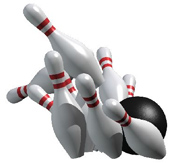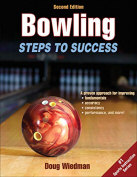How to Keep and Take Score in Bowling

Modern alleys do it automatically, but it is important to know how to keep score in bowling.
Most alleys today have automatic scoring, so you really won’t need to know how to take score in bowling. If you are looking to be a more serious bowler, or just curious, here is how you take score in ten pin bowling. The game of bowling is separated by ten frames. Each player has two shots each frame to knock all the pins down. There are several variations of bowling games. If you are bowling at an alley for casual fun and entertainment then you will probably be playing ten pin bowling. Here is a free bowling score sheet for you to download and print out and use to keep bowling scores.
The highest score someone can achieve is 300. This is a perfect game, and very few people have accomplished this score. In score keeping a game of bowling each set of ten pins is called a frame and an entire bowling game has ten frames. The object of each frame in bowling is to knock over all ten pins, and the object of the game is to have the highest score.
First you will write each player’s name on the scoring sheet in the name area. Next you will start the first frame and count how many pins were knocked down.
Find that players name on the sheet and write down how many pins were knocked down in the small box to the top left of the frame box.
Write the number of pins knocked down on the second try next to where u wrote the first try. Add these two numbers to get the total amount of pins knocked down in the larger of the boxes for that frame.
If a player in your group bowls a strike put an X in the frame box. A strike is worth ten points added to their pins that they knock down in their next two shots. If the next two shots are both strikes, that would be a total of 30 points for the first strike. Each frames strike then also gets added to the next two shots. Because of this, you may not know what a bowlers score is on that frame for up to two more frames.
A spare is when a player knocks down the remaining pins left behind from their first turn. When a player bowls a spare put a / in the frame box, a spare is worth ten points, plus the amount bowled on the next ball. Record this number in the totals area of that frame the spare was bowled on. You will not know what the bowlers score is until the next frame!
 If after the first ball in a frame the pins that are left are “split” (not next to each other), the number of pins rolled should be circled. If a bowler goes past the foul line, the turn is fouled and an F should be placed for that turn. And balls knocked over on a foul do not count. A foul does not forfeit the entire frame, so if a person fouled their first shot in a frame, they can still pick up a spare by knocking all 10 pins down on their next ball.
If after the first ball in a frame the pins that are left are “split” (not next to each other), the number of pins rolled should be circled. If a bowler goes past the foul line, the turn is fouled and an F should be placed for that turn. And balls knocked over on a foul do not count. A foul does not forfeit the entire frame, so if a person fouled their first shot in a frame, they can still pick up a spare by knocking all 10 pins down on their next ball.
The tenth frame is a little different. If you bowl a strike, you are still entitled to your 2 extra balls. So If you bowl a strike, the pins are reset just as it’s a new frame. The same goes for a spare. If you bowl a spare, the pins are reset and you get to bowl one more ball. The scoring remains the same though. If however, you bowl a strike or spare after your initial strike or spare in the 10th frame, you do not get to bowl any extra balls. The most balls you can roll in the 10th frame is 3.
This is an example of one person’s bowling score:

Once you have done all ten frames add all the players’ totals and enter them in the area given. Next, see who won and who is going to buy the winner a round of drinks or snacks. There you go, you now know all about bowling scores.
If you want to make sure you are on the winning side, Bowling For Dummies will teach you how to really raise your score and bowl better. This guide has every bowling secret and tip the pros know that will help you bowl your best. We have read this guide and our scores improved greatly.
Using ten pins in the game of bowling originated in colonial America to get around a gaming law that forbade bowling at nine pins.
